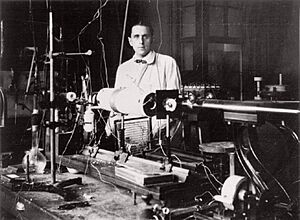Fritz Houtermans facts for kids
Quick facts for kids
Fritz Houtermans
|
|
|---|---|
 |
|
| Born | 22 January 1903 |
| Died | 1 March 1966 |
| Occupation | |
| Academic career | |
| Fields | Physics, nuclear physics, geochemistry, astrochemistry |
| Doctoral advisor | James Franck |
Friedrich Georg "Fritz" Houtermans (born January 22, 1903 – died March 1, 1966) was a brilliant physicist who studied atoms and how they work. He was born in Zoppot (now Sopot), near Danzig (now Gdańsk), which was then in West Prussia. His father was a wealthy banker from the Netherlands.
Fritz grew up in Vienna, Austria, where he went to school. When he was 18, he moved to Göttingen, Germany, to study physics. There, he earned his Ph.D. under the famous scientist James Franck.
Contents
Studying Physics
Fritz Houtermans started his studies at the University of Göttingen in 1921. He earned his doctorate degree in 1927. This was the same year that Robert Oppenheimer also got his doctorate there. Later, in 1932, Fritz completed another important step in his academic career at Technische Universität Berlin. His mentors, Gustav Hertz and James Franck, were both Nobel Prize winners in physics.
While at Göttingen, Houtermans met many other future famous scientists. These included Enrico Fermi, George Gamow, Werner Heisenberg, and Wolfgang Pauli.
Big Discoveries
In 1928, Houtermans and George Gamow did important early work on something called quantum tunneling. This is a strange effect where tiny particles can pass through barriers, even if they don't have enough energy to go over them.
A year later, in 1929, Houtermans and Robert d'Escourt Atkinson made a huge discovery. They were the first to calculate how stars create energy. They figured out that stars make energy through nuclear reactions, like a giant fusion furnace. Their ideas helped other scientists, like Carl Friedrich von Weizsäcker and Hans Bethe, develop the full theory of how stars shine.
Love and Marriage
Fritz Houtermans met Charlotte Riefenstahl at the University of Göttingen. She was also a physicist and earned her doctorate in 1927. Fritz and Charlotte got married in August 1930 in Tbilisi, Georgia. Two other famous physicists, Wolfgang Pauli and Rudolf Peierls, were witnesses at their wedding.
Working Life and Challenges
From 1932 to 1933, Houtermans taught at Technische Universität Berlin. He also worked as an assistant to Gustav Hertz. During this time, he met other important scientists like Patrick Blackett and Leó Szilárd.
Leaving Germany
Fritz Houtermans was a Communist and had joined the German Communist Party in the 1920s. When Adolf Hitler came to power in Germany in 1933, Charlotte insisted they leave the country. They moved to Great Britain, near Cambridge, where Fritz worked at a television laboratory.
In 1935, Houtermans moved to the Soviet Union. He worked at the Kharkov Physico-Technical Institute for two years.
Imprisonment and Release
During a difficult time in the Soviet Union known as the Great Purge, Fritz Houtermans was arrested in December 1937. He was put in prison and pressured to confess to being a spy. He did so out of fear for his wife, Charlotte, who had already managed to escape to Denmark, then England, and finally the USA.
In May 1940, after the Hitler-Stalin Pact was signed, Houtermans was handed over to the German secret police, the Gestapo. He was then imprisoned in Berlin. Luckily, a scientist named Max von Laue helped him get released in August 1940.
After his release, Fritz started working at a private laboratory in Berlin. This lab was owned by Manfred von Ardenne.
Secret Work and a Warning
While working at Manfred von Ardenne's lab, Houtermans made an important discovery. He showed that new elements, like neptunium and plutonium, could be used as fuel for nuclear reactions, just like uranium.
During World War II, Houtermans secretly sent a message from Switzerland to Eugene Wigner in the United States. Wigner was working on the Manhattan Project, which was the American effort to build an atomic bomb. Houtermans' message warned them about Germany's progress in nuclear research. He simply said: "Hurry up. We are on the track." This was a risky act of espionage against his own country.
A Peculiar Incident
Fritz Houtermans was a heavy smoker. While working at the Physikalisch-Technische Bundesanstalt, he got into trouble because he really needed tobacco. He wrote a letter to a cigarette company, claiming he needed a special kind of tobacco to extract "heavy water," which he said was important for the war effort. This was not true, and he just wanted to smoke it! When he asked for more, his letter was seen by an official, and he was fired.
Luckily, Werner Heisenberg and Carl Friedrich von Weizsäcker helped him. They arranged for him to get new jobs in Göttingen in 1945.
Later Career
In 1952, Houtermans became a professor of physics at the University of Bern in Switzerland. There, he started a group called "Berner Schule." This group focused on using radioactivity to study space, the chemicals in the universe, and the Earth's geology.
Family Life
Fritz Houtermans was married four times. Charlotte Riefenstahl was his first wife, and they had two children: a daughter named Giovanna (born in 1932) and a son named Jan (born in 1935). They divorced in 1943.
In 1944, Fritz married Ilse Bartz, a chemical engineer. They worked together and had three children: Pieter, Elsa, and Cornelia.
In 1953, Charlotte and Fritz got married again, with Wolfgang Pauli as a witness once more. But they divorced again just a few months later.
In 1955, Houtermans married Lore Müller. She had a daughter, and they had a son together named Hendrik, born in 1956.
Fritz Houtermans passed away on March 1, 1966, at the age of 63.
See also
 In Spanish: Fritz Houtermans para niños
In Spanish: Fritz Houtermans para niños
- Stellar nucleosynthesis
- ZETA (fusion reactor)

